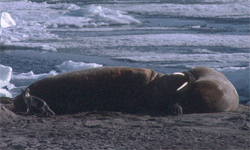Arctic Ocean LME
Introduction
The Arctic Ocean Large Marine Ecosystem (LME) lies between North America, Greenland and Asia beyond the Arctic Circle at 66 degrees North latitude. The geography of this region is complex. The Arctic Ocean is almost completely enclosed and close to, and influenced by, large populations and industrial activities. Surface water enters the Ocean through the shallow Bering Straits and through the eastern part of the Fram Strait. These source waters are modified by river runoff and meltwater in summer and by salt rejection during freezing in winter resulting in its characteristic surface brackish layer (lower salinity). The Arctic is dominated by permanent ice cover which opens significantly during summer only in the coastal seas to the north of Asia, Alaska and the Canadian Northwest Territories. Both the Arctic and the Antarctic have notable year to year variations in ice cover although there is an upward trend. This warming trend, if continued, will not only significantly affect global climate but will also greatly change the strategic and economic importance of the Arctic Ocean through its use for commercial shipping routes and increased development of natural resources.
Biology
The Arctic Ocean is classified as a low productivity ecosystem, a consequence of the extensive seasonal ice cover and extreme weather conditions. The Arctic plankton show weak diurnal vertical migrations but pronounced seasonal ones. The Arctic fauna is impoverished and consists mainly of organisms derived from the Atlantic Ocean. The biomass is lower than in the Antarctic; often dominated by one of only a few species. Because of the extensive areas of sediments, the Arctic benthic fauna is mainly an infauna. Specialized endemic fish are not present in the Arctic, in contrast to the Antarctic. The distribution of birds is longitudinal with strong differences between communities at similar latitudes in different parts of the Arctic Ocean basin. Marine mammals are diverse. The human population is small.
Pollution and Ecosystem Health
Pressures on the Arctic Ocean LME are derived from both global and local sources. Pollutants generated in Europe, Asia and North America are transported very effectively into the Arctic environment by the atmospheric and oceanic circulation processes. These include persistent organic pollutants (POPs) from industrial and agricultural practices (e.g. metal smelters, paper and waste processing plants, pesticides, and herbicides), heavy metals (e.g. lead from petrol) and radionuclides (e.g. emissions from reprocessing plants and accidents). In recent years there has been a perception on the part of some of the Inuit hunters in Nunavut (the eastern Canadian Arctic) that they may be seeing more abnormalities in the marine mammals they harvest for food and income. Some Arctic indigenous groups, which rely heavily on food from species at high trophic levels in both marine and terrestrial ecosystems, show levels of POPs in tissue and breast milk significantly higher than those found in more southerly populations. More.
Socio-Economic and Governance
The marine environment surrounding the Arctic has been highly disturbed by fishing activity, but, in terms of pollution, some areas remain among the most pristine in the world. The greatest concern for the Arctic Ocean LME is probably the ecological implications of climate change, particularly as sea ice extent and duration are likely to be affected. There are international efforts to protect the Arctic and its marine life through the Program for the Conservation of Arctic Flora and Fauna (CAFF). With a secretariat based in Iceland, this program cooperates with the Program for the Protection of the Arctic Marine Environment (PAME).



